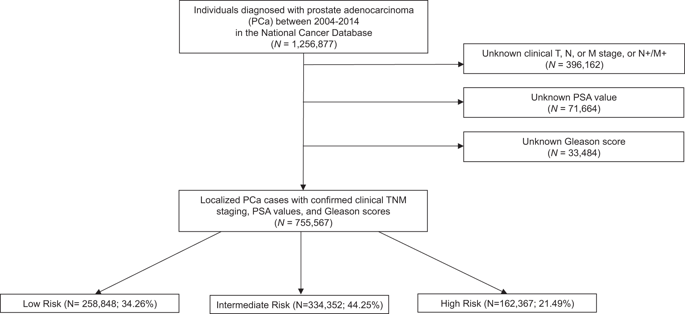当前位置:
X-MOL 学术
›
Prostate Cancer Prostatic. Dis.
›
论文详情
Our official English website, www.x-mol.net, welcomes your feedback! (Note: you will need to create a separate account there.)
Contemporary national trends in prostate cancer risk profile at diagnosis.
Prostate Cancer and Prostatic Diseases ( IF 4.8 ) Pub Date : 2019-06-24 , DOI: 10.1038/s41391-019-0157-y Sean A Fletcher 1, 2 , Nicolas von Landenberg 2, 3 , Alexander P Cole 1, 2 , Philipp Gild 2, 4 , Toni K Choueiri 5 , Stuart R Lipsitz 2 , Quoc-Dien Trinh 1, 2 , Adam S Kibel 1
Prostate Cancer and Prostatic Diseases ( IF 4.8 ) Pub Date : 2019-06-24 , DOI: 10.1038/s41391-019-0157-y Sean A Fletcher 1, 2 , Nicolas von Landenberg 2, 3 , Alexander P Cole 1, 2 , Philipp Gild 2, 4 , Toni K Choueiri 5 , Stuart R Lipsitz 2 , Quoc-Dien Trinh 1, 2 , Adam S Kibel 1
Affiliation

|
BACKGROUND
Over the past decade prostate cancer (PCa) diagnostic approaches have evolved away from aggressive prostate-specific antigen (PSA) screening. While a goal of these changes is to decrease over diagnosis and treatment, little is known about the downstream effects on PCa risk distribution at the time of diagnosis. To better understand these effects, we used a national cohort of men to investigate temporal trends in PCa risk profile at diagnosis.
METHODS
Using the National Cancer Database, we identified men diagnosed with biopsy-confirmed clinically localized prostate adenocarcinoma (T1-4N0M0) from 2004 to 2014. We assessed temporal trends in proportional distribution of National Comprehensive Cancer Network risk groups as well as their sub-components (PSA, Gleason score, clinical T stage). We also evaluated trends in these sub-components among men with intermediate- and high-risk disease as well as those with metastatic disease.
RESULTS
In our cohort of 755,567 men diagnosed between 2004 and 2014, there was a decrease in the proportion of men diagnosed with low-risk PCa (38.32 to 27.23%, p < 0.001) and a consequent increase in the proportion of localized intermediate-risk (40.49 to 46.72%, p < 0.001) and high-risk diagnoses (21.19 to 26.05%, p < 0.001). This was primarily driven by an increased proportion of Gleason 7 and Gleason 8-10 cancer, respectively. The number of men presenting with metastatic disease consistently increased from 3251 (2.88%) in 2004 to 6886 (7.19%) in 2014 (p < 0.001).
CONCLUSIONS
The proportion of localized intermediate/high risk and metastatic PCa has substantially increased over the past decade, while the proportion of low-risk disease has decreased. This shift has been primarily driven by increased diagnosis of high-grade disease. National guidelines advising against PSA screening may have contributed to these findings.
中文翻译:

诊断时前列腺癌风险概况的当代国家趋势。
背景在过去十年中,前列腺癌 (PCa) 诊断方法已经从积极的前列腺特异性抗原 (PSA) 筛查演变而来。虽然这些变化的目标是减少过度诊断和治疗,但在诊断时对 PCa 风险分布的下游影响知之甚少。为了更好地了解这些影响,我们使用了一个全国男性队列来调查诊断时 PCa 风险状况的时间趋势。方法 使用国家癌症数据库,我们确定了 2004 年至 2014 年诊断为活检确诊的临床局限性前列腺腺癌 (T1-4N0M0) 的男性。我们评估了国家综合癌症网络风险组及其子组成部分比例分布的时间趋势(PSA,格里森评分,临床 T 分期)。我们还评估了中危和高危男性以及转移性疾病男性中这些子成分的趋势。结果 在 2004 年至 2014 年间诊断出的 755,567 名男性中,诊断出低危 PCa 的男性比例下降(38.32% 至 27.23%,p < 0.001),局部中危前列腺癌的比例随之增加。 (40.49 至 46.72%,p < 0.001)和高风险诊断(21.19 至 26.05%,p < 0.001)。这主要是由于 Gleason 7 和 Gleason 8-10 癌症的比例增加所致。患有转移性疾病的男性人数从 2004 年的 3251 人(2.88%)持续增加到 2014 年的 6886 人(7.19%)(p < 0.001)。结论 在过去十年中,局部中/高风险和转移性 PCa 的比例大幅增加,而低风险疾病的比例有所下降。这种转变主要是由于对高级别疾病的诊断增加。建议反对 PSA 筛查的国家指南可能促成了这些发现。
更新日期:2019-11-18
中文翻译:

诊断时前列腺癌风险概况的当代国家趋势。
背景在过去十年中,前列腺癌 (PCa) 诊断方法已经从积极的前列腺特异性抗原 (PSA) 筛查演变而来。虽然这些变化的目标是减少过度诊断和治疗,但在诊断时对 PCa 风险分布的下游影响知之甚少。为了更好地了解这些影响,我们使用了一个全国男性队列来调查诊断时 PCa 风险状况的时间趋势。方法 使用国家癌症数据库,我们确定了 2004 年至 2014 年诊断为活检确诊的临床局限性前列腺腺癌 (T1-4N0M0) 的男性。我们评估了国家综合癌症网络风险组及其子组成部分比例分布的时间趋势(PSA,格里森评分,临床 T 分期)。我们还评估了中危和高危男性以及转移性疾病男性中这些子成分的趋势。结果 在 2004 年至 2014 年间诊断出的 755,567 名男性中,诊断出低危 PCa 的男性比例下降(38.32% 至 27.23%,p < 0.001),局部中危前列腺癌的比例随之增加。 (40.49 至 46.72%,p < 0.001)和高风险诊断(21.19 至 26.05%,p < 0.001)。这主要是由于 Gleason 7 和 Gleason 8-10 癌症的比例增加所致。患有转移性疾病的男性人数从 2004 年的 3251 人(2.88%)持续增加到 2014 年的 6886 人(7.19%)(p < 0.001)。结论 在过去十年中,局部中/高风险和转移性 PCa 的比例大幅增加,而低风险疾病的比例有所下降。这种转变主要是由于对高级别疾病的诊断增加。建议反对 PSA 筛查的国家指南可能促成了这些发现。


























 京公网安备 11010802027423号
京公网安备 11010802027423号